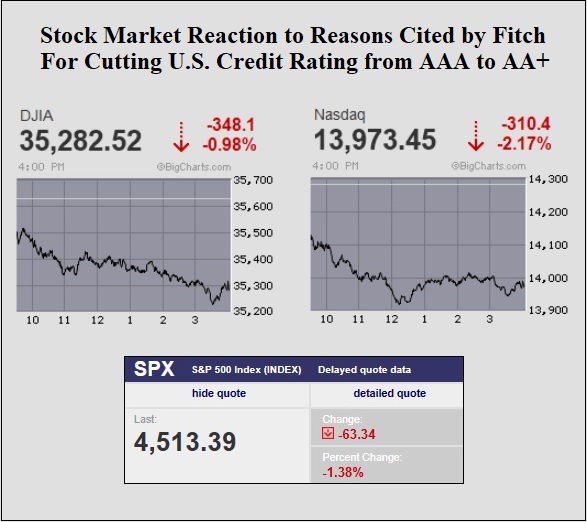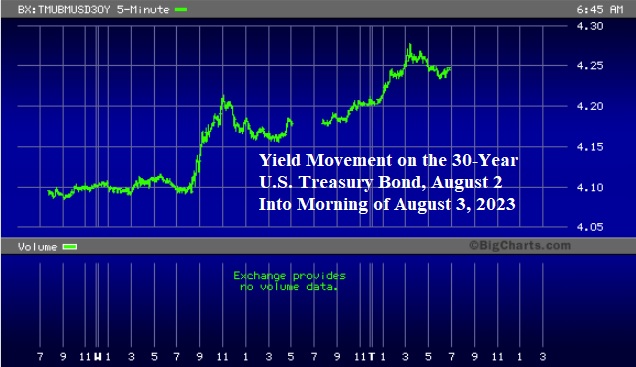By Pam Martens and Russ Martens: August 3, 2023 ~
At 5:13 p.m. ET on Tuesday, after the stock market closed, Fitch downgraded the U.S. credit rating from AAA to AA+. Fitch is now the second of the three major credit rating agencies to have taken the historic step of removing the triple-A rating from the U.S. S&P made its first-ever downgrade to the U.S. credit rating on August 5, 2011, also from AAA to AA+, and has kept it there ever since. Moody’s is now the only member of the Big Three credit rating agencies that has maintained a triple-A rating on the U.S.
As the chart above indicates, the stock market responded negatively to this development yesterday, particularly over the fact that it came at a time when the U.S. Treasury is boosting the amount of debt it is issuing.
Yesterday, the U.S. Treasury announced its plans to increase its debt issuance, writing as follows:
“Based on projected intermediate- to long-term borrowing needs, Treasury intends to gradually increase coupon auction sizes beginning with the August to October 2023 quarter. While these changes will make substantial progress towards aligning auction sizes with intermediate- to long-term borrowing needs, further gradual increases will likely be necessary in future quarters….”
In line with that view, the Treasury boosted its auction set for next week from $96 billion to $103 billion, consisting of $42 billion in a 3-year Treasury note; $38 billion in a 10-year Treasury note; and $23 billion in a 30-year Treasury bond.
Yields on both the 10-year note and 30-yield bond saw increases in their yields yesterday, meaning their prices were declining. (Bond prices move inversely to their yields.) The yield on the 10-year was trading in the range of 4.05 percent in the early morning yesterday, then moved up to 4.12 by late afternoon. It has continued to move higher this morning, yielding 4.15 percent at 7 a.m. The yield on the 30-year bond was trading in the range of 4.10 early yesterday morning, then moved sharply up at the day progressed, reaching a yield of 4.20 by 11 a.m. This morning, at 7 a.m., the 30-year is yielding 4.25 percent.
When S&P downgraded the U.S. credit rating in 2011, it cited as one factor the growing U.S. debt as a percent of GDP. It said it anticipated U.S. debt reaching “an estimated 74% of GDP by the end of 2011 to 79% in 2015 and 85% in 2021,” while noting that these ratios were “high in relation to those of peer credits….”
Those ratios look positively Goldilocks compared to today. One of the points made by Fitch in its ratings downgrade on Tuesday was this:
“Lower deficits and high nominal GDP growth reduced the debt-to-GDP ratio over the last two years from the pandemic high of 122.3% in 2020; however, at 112.9% this year it is still well above the pre-pandemic 2019 level of 100.1%. The GG [General Government] debt-to-GDP ratio is projected to rise over the forecast period, reaching 118.4% by 2025. The debt ratio is over two-and-a-half times higher than the ‘AAA’ median of 39.3% of GDP and ‘AA’ median of 44.7% of GDP. Fitch’s longer-term projections forecast additional debt/GDP rises, increasing the vulnerability of the U.S. fiscal position to future economic shocks.”
But what is causing the most discussion behind the scenes, both domestically and abroad, are the concerns Fitch enumerated on the ability of the U.S. to govern itself. Fitch raised the following governance issues:
“In Fitch’s view, there has been a steady deterioration in standards of governance over the last 20 years, including on fiscal and debt matters, notwithstanding the June bipartisan agreement to suspend the debt limit until January 2025. The repeated debt-limit political standoffs and last-minute resolutions have eroded confidence in fiscal management. In addition, the government lacks a medium-term fiscal framework, unlike most peers, and has a complex budgeting process….”
Debt-limit standoffs are, unfortunately, not the only political standoffs. It’s difficult for ratings agencies, or the rest of the world for that matter, to forget that it was just over 2-1/2 years ago that the seat of government, the U.S. Capitol, faced a bloody insurrection — by American citizens. Photographs of that out-of-control scene made the front pages of newspapers around the world, as we chronicled here.
One comment from Fitch on U.S. governance on Tuesday seemed far too generous. It said that according to the World Bank Governance Indicators (WBGI), the “U.S. has a high WBGI ranking at 79, reflecting its well-established rights for participation in the political process, strong institutional capacity, effective rule of law and a low level of corruption.”
A “low level of corruption.” Let that sink in slowly for a few minutes. The immediate past president of the United States, Donald Trump, has now been indicted for the third time. The largest bank in the United States, JPMorgan Chase, (which has already been charged by the Justice Department with five criminal felony counts since 2014 and admitted to all of them), is in the midst of a federal lawsuit in Manhattan where the Attorney General of the U.S. Virgin Islands has produced hundreds of documents, internal emails, and transaction reports showing that the bank actively participated in the child sex trafficking operation of Jeffrey Epstein for more than a decade, with its tentacles reaching men in high places in the U.S. And the investigation of insider trading at the central bank of the United States, the worst scandal in the 110 year history of the Federal Reserve, is being stonewalled by the Fed’s Inspector General. The criminal division of the U.S. Department of Justice has yet to weigh in on either the JPMorgan case or the Fed’s trading scandal, despite both being of critical national importance.
There is a website where one can look at the front pages of newspapers across America on any given day to gauge the concerns of our fellow citizens. Yesterday, we checked small and medium size newspapers across the country to see if any newspaper reported the Fitch downgrade of the U.S. credit rating on its front page. Of the two dozen newspapers we sampled, we couldn’t find any mention of the credit downgrade.
The Star Ledger in Newark, New Jersey found room to mention on its front page that the New York Mets had traded Justin Verlander to the Houston Astros, but not a peep about the U.S. losing another AAA rating from a Big Three credit agency.
The Detroit News didn’t think its front page needed the Fitch news but it did make room to tell its readers that Michael Lorenzen was being traded by the Tigers to the Phillies.
What was making front page news across America yesterday was Trump’s indictment. The Atlanta Journal-Constitution ran a bold font, all-caps headline: “TRUMP FACES FOUR FELONY COUNTS.” Directly below that was a picture of carefree elementary school children heading into school for the first day of classes. (Schools open in August in some parts of the United States.)
PBS summarized the escalating corruption charges around Trump like this: “Special counsel Jack Smith, who indicted Trump in the election case, has also charged Trump in federal court with the illegal retention of top secret documents. In New York, Trump faces criminal charges in a hush money case and a civil trial over his business practices. And in Georgia, a county district attorney is expected to announce charging decisions in August over efforts by Trump and his allies to overturn his 2020 election loss in the state.”
It’s important to remember that Trump came to power because the two major political parties gave U.S. voters the following two choices in 2016: elect Hillary Clinton as President despite the fact that she had outsourced Top Secret documents during her time as Secretary of State, from the safety of government controls to a private server in the basement of her New York home that lacked any government protections. Or, voters could elect Donald Trump, who had taken his businesses into bankruptcy six times and had been charged with serial sexual assaults by women, while admitting on camera to grabbing them in their genital area and getting away with it.
But, hey, it’s good to know that the World Bank thinks the U.S. has “a low level of corruption.”



